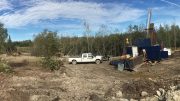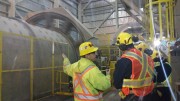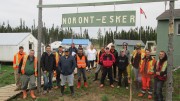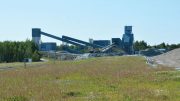A positive preliminary economic assessment (PEA) suggests Rubicon Minerals’ (TSX: RMX; US-OTC: RBYCF) once-troubled Phoenix gold project in northwestern Ontario could rise again.
Trial mining of Phoenix’s F2 gold deposit was called off in late 2015 after the first gold pour, when the company’s previous management team ran into problems reconciling grades, and realized the geology was more complex than they had anticipated. Rubicon’s current president and CEO, George Ogilvie, stepped into the breach in December 2016, restructured the company, and ran a test-trial mining and 35,000-tonne bulk-sample processing program last year.
In March, Rubicon updated F2’s resource estimate to 2.93 million measured and indicated tonnes grading 6.26 grams gold per tonne for 589,000 contained oz. gold, and 2.57 million inferred tonnes averaging 6.53 grams gold per tonne for 540,000 oz. gold.
A PEA in August outlined a mine life of just over six years, with total production of 493,583 oz. gold — or 79,610 oz. per year — using a base case gold price of US$1,325 per ounce.
Initial capital to put the mine into commercial production is estimated at $101.2 million. That’s because the project benefits from more than $770 million in sunk capital and a mine that has been 95% built, including a fully operational mill, a 730-metre-deep shaft and hoisting facility, more than 14,000 metres of developed mine workings, a permitted tailings pond, and a 200-man camp.
Sustaining capital over the life-of-mine is pegged at $154 million.

Surface facilities at Rubicon Minerals’ Phoenix gold project in Ontario. Credit: Rubicon Minerals.
The PEA forecasts a 40.2% after-tax internal rate of return and $191.5 million in after-tax, free cash flow — numbers that benefit not only from the sunk capital, but also access to $690 million of tax-deductable pools, tax losses and tax credits.
The study estimates that applying $300 million in tax-loss pools improves the life-of-mine free cash flow by $95.5 million. What’s more, at the end of the current mine life, Rubicon would still have $521 million of unused federal tax-loss pools, which could generate more than $100 million in future free cash flow for the company.
“One of the big things that I don’t think people are picking up on, are these tax-loss pools,” Ogilvie says in an interview. “If $300 million of tax pools gives you $95 million in additional free cash flow, those tax pools will generate more than $200 million in free cash flow over a 10-year period, and here we are at a market cap of about $80 million. It’s amazing.”
The PEA envisions 26,608 metres of underground development. About 6,000 metres of underground development, including a ramp to surface, is planned during the pre-commercial production period, which would give the company access to 40 to 50 working stopes.
Ogilvie and his team say they can enhance the project’s economics through resource expansion at depth and along strike. The bottom of the mineralization included in the PEA sits at a 1,400-metre depth, Ogilvie notes, but the former Rubicon team found mineralization in sparsely spaced drilling as deep as 1,600 metres below surface.
“That’s why we have a non-compliant category of ‘explored ounces’ that is anywhere between 5 and 7 grams, and approximately 1 million tonnes,” Ogilvie says. “If you work that out, it’s going to be anything around 150,000 ounces … that need to be infill drilled to move it into a higher resource class, and that can add another one or two years to the mine life. The deposit has never been cut off at depth, and next door at the [Campbell and Red Lake] producing mines of Newmont Goldcorp, the high-grade zones were all discovered below 2,000 metres underground.”
Moreover, if the deeper material could be brought into inferred resources, he says, Rubicon wouldn’t need to lower the shaft — the material could be trucked up to surface or up to a loading pocket. “If trucks were trucking it up from the 1,600 level, they theoretically could go up to the 600-metre level — that’s where our main haulage level is — so there’s no requirement to extend the shaft down or sink any internal winze.”
Rubicon also says it has targets within 2 km of the deposit that it plans to drill that could affect the project’s economics. The company has a 285 sq. km land package — 40% of all claims in the province’s Red Lake district.
In addition, management is looking at other ways to optimize the results, such as greater use of raise mining with mass blasts, which would trim stope cycle time and costs, ore-sorting technology that might improve mill head grade, and electric underground trucks to lower ventilation costs.
The next step is to update the resource before year-end to convert more inferred ounces into the measured and indicated category so that work can begin in the new year on completing a feasibility study. “We just want mineable reserves in a feasibility study that show robust economic returns so project financing can be completed, and we can move this into commercial production over a 20-month period,” Ogilvie says.
Drill core from Rubicon Minerals’ Phoenix project. Credit: Rubicon Minerals.
The mining executive says the company could finish a feasibility study in eight to nine months, taking into account existing infrastructure and development, and the fact that there aren’t many unknown costs outstanding.
“The results of the PEA are extremely pleasing, given that we’ve used quite conservative assumptions in putting the business case together, and, even in the mine planning, the operating and capital costs are all real numbers that we’ve seen over the last five to six years,” he says.
What’s more, productivity rates in the PEA are a little low, he adds, “meaning that there’s also an opportunity to speed things up and accelerate to commercial production, so at the end of the day we feel we can deliver on these results, and probably get superior ones when we come out with our feasibility study next year.”
Before joining Rubicon, Ogilvie was CEO of Kirkland Lake Gold (TSX: KL; US-OTC: KLGDF) from 2013 to 2016, and before that, was CEO of Rambler Metals and Mining (TSXV: RAB; LON-RMM). When Rubicon restructured, the mining executive put $650,000 of his own money into the company at an average weighted price of $1.37 per share.
“You’re starting to see how management is systematically de-risking this project, building back the confidence, being conservative and prudent in its assumptions and delivering on what it says it’s going to do, and over time people are going to realize you’ve got a commercially viable mine in one of the tier-one mining jurisdictions in the world, and a company that is significantly undervalued.”
Rubicon shares sold for $1.10 at press time within a 52-week range of 61¢ to $1.52. The company has 77 million common shares outstanding for an $83-million market capitalization.





It sure would be nice to get the project moving again.